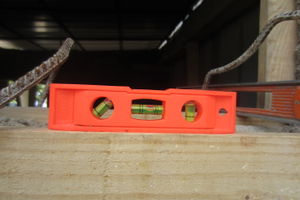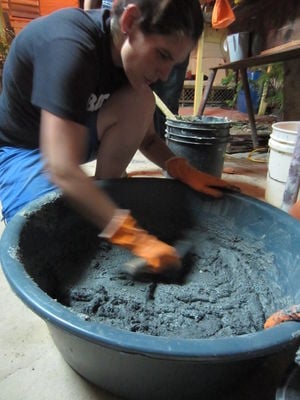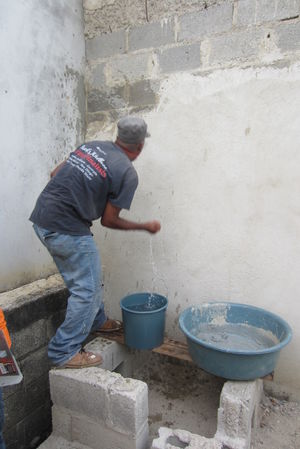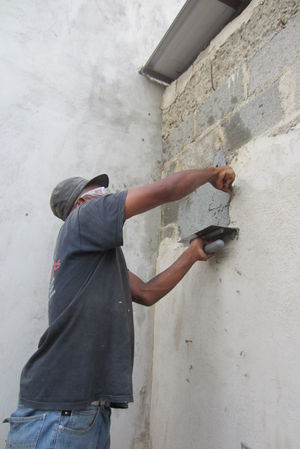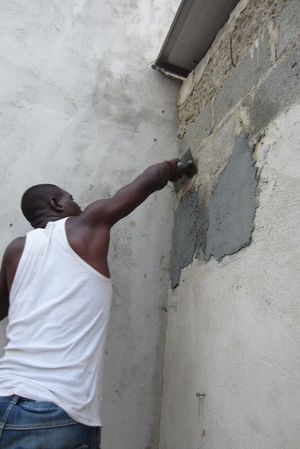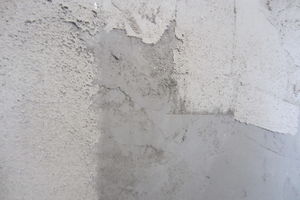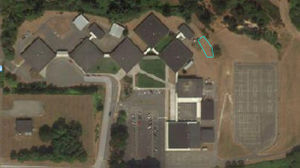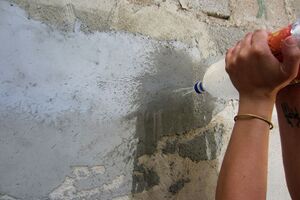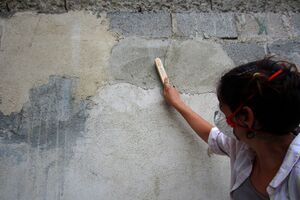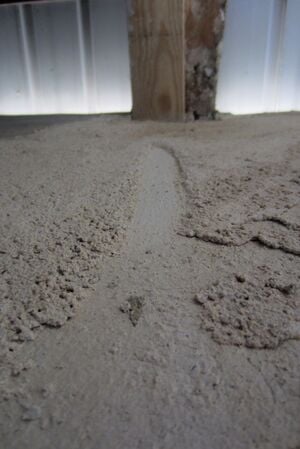(→Lime) |
(→Lime) |
||
| Line 209: | Line 209: | ||
=====Lime===== | =====Lime===== | ||
Lime plaster is typically composed of lime and sand, and can be utilized for exterior or interior walls. Oftentimes, however, lime plaster is "usually applied on exterior walls where it provides excellent protection against the elements" <ref name="Nat Plaster"/>. Lime differs from other earthen plasters in the fact that it takes a somewhat energy-intensive process to get the lime from its naturally occurring source, such as limestone. To create lime, a type of powder called quicklime (heated and crushed limestone) must be hydrated in a process called | Lime plaster is typically composed of lime and sand, and can be utilized for exterior or interior walls. Oftentimes, however, lime plaster is "usually applied on exterior walls where it provides excellent protection against the elements" <ref name="Nat Plaster"/>. Lime differs from other earthen plasters in the fact that it takes a somewhat energy-intensive process to get the lime from its naturally occurring source, such as limestone. To create lime, a type of powder called quicklime (heated and crushed limestone) must be hydrated in a process called 'slaking'. This is basically the calcium oxide and magnesium oxide reacting with water to create the lime paste that is used in lime-based plasters. This process works best over a large time frame. If lime plaster dries too quickly, it can destroy it completely as an efficient plaster. While lime is caustic and can cause extreme damage upon contact with skin or inhalation, there are many advantages to using lime. Lime plasters are not only aesthetically pleasing, but they are also "vapor permeable." <ref name="Nat Plaster"/> This allows for the movement of water molecules through the material, protecting against moisture-related issues such as rot and mold. | ||
It is also important to note that lime plaster requires a lime wash every 4-5 years. <ref name="One Community">One Community [Online] Available http://www.onecommunityglobal.org/plaster/#types</ref> The wash is needed to allow the building to breath. Though it is expensive, it improves the condition of the underlying plaster. | It is also important to note that lime plaster requires a lime wash every 4-5 years. <ref name="One Community">One Community [Online] Available http://www.onecommunityglobal.org/plaster/#types</ref> The wash is needed to allow the building to breath. Though it is expensive, it improves the condition of the underlying plaster. | ||
Lime plaster is best composed of high calcium and low amounts of magnesium. When stored, it is vital to have one or two inches of water on top to prevent carbonation from exposure to the air - just like in the process of making the plaster - and must be fully slaked before the application may begin. A desirable technique is to apply lime plaster in one to three coats of varying composition, and using a mortar mixer rather than a cement mixer, to avoid the material sticking to the walls of the drum. The first two coats use one part lime putty and two to three parts sand, while the last coat has a higher ratio of one and a half to three parts sand. Sand within the plaster adds tensile strength, but it is important to be aware of the type of sand being used. Small grains can cause the plaster to crack or rub off because of the lack of strength. Additionally, uniformly sized particles cause cracking due to the ability of the material to shear along many edges. The best sand to use is one that has non-uniformly sized particles, as well as particles without smooth edges that may shear easily. It is important to note that beach sand must be cleaned prior to use because of the salt content. Salt has a tendency to move out from the plaster, which creates white patches on the surface. <ref name="Nat Plaster"/> | Lime plaster is best composed of high calcium and low amounts of magnesium. When stored, it is vital to have one or two inches of water on top to prevent carbonation from exposure to the air - just like in the process of making the plaster - and must be fully slaked before the application may begin. A desirable technique is to apply lime plaster in one to three coats of varying composition, and using a mortar mixer rather than a cement mixer, to avoid the material sticking to the walls of the drum. The first two coats use one part lime putty and two to three parts sand, while the last coat has a higher ratio of one and a half to three parts sand. Sand within the plaster adds tensile strength, but it is important to be aware of the type of sand being used. Small grains can cause the plaster to crack or rub off because of the lack of strength. Additionally, uniformly sized particles cause cracking due to the ability of the material to shear along many edges. The best sand to use is one that has non-uniformly sized particles, as well as particles without smooth edges that may shear easily. It is important to note that beach sand must be cleaned prior to use because of the salt content. Salt has a tendency to move out from the plaster, which creates white patches on the surface. <ref name="Nat Plaster"/> | ||
=====Gypsum===== | =====Gypsum===== | ||
Revision as of 02:37, 30 June 2015

Abstract
Background
This project was included in Lonny Grafman's Practivistas summer program through Humboldt State University HSU. It took place from May 22-July 4, 2015 in the small community, Las Malvinas, located in the outskirts of Santo Domingo, Dominican Republic. The task at hand was to finish the botica popular, which was built in summer, 2013, by other Practivista students Las Malvinas botica popular hullkrete 2013. Working with the community, seven Practivistas students designed and implemented this project based on the current criteria at hand. The project team was composed of a group of six students studying at Humboldt State University, all members of Lonny Grafman's Practivistas program. The project entailed making and applying plaster to the botica, laying out a floor for it, and providing materials needed for the electric plan of the building.
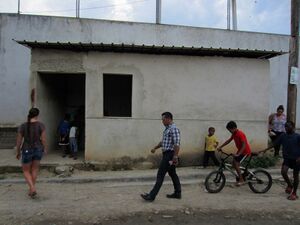
Objective
The objective of this project is to complete the botica popular in Las Malvinas in a way that best fits the criteria discussed, while hopefully providing the community with a finished product of what will become a reliable source of much needed medicine.
Criteria
English
The criteria below represents key aspects of this project in weighted form, which is a list of the key elements providing support and foundation to the design and building decisions made throughout. It stands as a guide to all decision-making for this project.
| Criteria and Description | |||||
|---|---|---|---|---|---|
| Criteria | Weight | Description | |||
| Safety | 10 | The structure must provide security for those using it as well as trust in the structure. It is also important that the materials used to create the structure cause no harm to the public, or less harm than the standard, given that necessary safety precautions are taken. | |||
| Durability | 9 | The lifespan is suitable for the consumer given that the money needed to fix or replace the structure can be saved by the time the structure is in need. The structure is also able to withstand the extremes of average weather conditions. | |||
| Environmental Impact | 9 | To have a less negative affect on the world than the standard that's commonly used. | |||
| Aesthetics | 7 | Build a finished looking, smooth and trustworthy structure. | |||
| Time | 6 | The importance of spending all of the constrained amount of time on a given project. | |||
| Educational Value | 6 | The ability for the building to be easily understood and more deeply learned about and replicated if there was a desire to do so. | |||
| Cost | 5 | The importance of spending all of the constrained amount of money on a given project. | |||
| Accesibility of Materials | 5 | The time it takes to obtain a material must be within the constrained amount. As well the ability to transport the material should be taken into consideration for whether it can be carried or delivered in that set amount of time. | |||
Español
| Criterio y Descripción | |||||
|---|---|---|---|---|---|
| Criterio | Importancia | Descripción | |||
| Seguridad | 10 | Este estructura debe a proveer seguridad para aquellos que usar y también para confiar en la estructura. También es importante que los materiales usado para crear la estructura no causa nada lastima al público, o menos lastima de la norma cuando se toman las precauciónes apropriadas. | |||
| Durabilidad | 9 | La vida de la estructura es apropriado para el cliente, dado que el necesario dinero para reparar o sustituir el estructura puede ser ahorrado al tiempo que es necesario. La estructura también puede resistir algunos de los corrientes extremos del tiempo. | |||
| Impacto Ambiental | 9 | Para hacer efectos menos mál en el mundo y ambiento de la norma. | |||
| Estética | 7 | Construir una estructura que ve terminada, suave y que puede confiar en. | |||
| Tiempo | 6 | La importancia para usar todo del tiempo asignado para un proyecto. | |||
| Valor Educativo | 6 | La abilidad para entender el edificio y aprender más y para replicar si la comunidad quiere. | |||
| Costo | 5 | La importancia para usar todo del dinero asignado para un proyecto. | |||
| Accesibilidad de Materiales | 5 | El tiempo necesario para obtener un material debe estar adentro de nos tiempo asignado. También, la poder para transportar un material debe estar pensando para saber si se llevar un material o debe estar poner en un carro para llevar adentro del tiempo asignado. | |||
Literature Review
The purpose of this literature review is to present facts and researched information relating to the 2015 Botica/Ecoblock/Destacamento project taking place in a community in the Dominican Republic called Las Malvinas. This information is to guide the decisions made upon different aspects of the designing and building of this assortment of projects, and to further guide those wanting to pursue any future projects related to green building.
Climate and Location
Las Malvinas, the community of interest, is located in the city of Santo Domingo, Dominican Republic. On average, Santo Domingo gets about 200 hours of sunlight each month, with temperatures - on average - ranging from about 19 degrees Celsius to around 32 degrees Celsius. The average monthly rainfall can get up to about 190 millimeters in one month, and is greatest from May to October. The average humidity of the area ranges generally between 80% and 90% [1] Santo Domingo is located in the tropical area of the Caribbean Sea and, as shown previously, has some variation through the seasons in average reports for rainfall and temperatures [2].
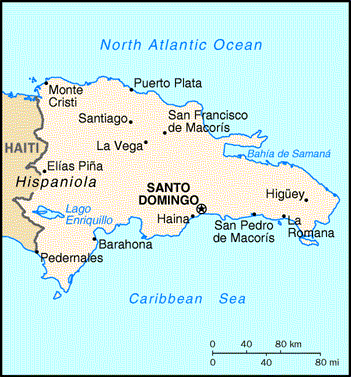
Flooring
How to Tutorials for application technique:
Best Concrete Flooring: Free Tutorial over tile
DIY Network: Installing a Concrete Floor
DIY Network: How to Install a Skim Coat for a Concrete Floor
DIY Network: How to Repair Holes in Concrete Floors
Images of Concrete Floors with staining designs
Installation
For installing a concrete floor, some considerations must be taken into consideration such as protecting the inner walls of the room(s) and also laying out the floor in a leveled fashion. Some research shows the steps for installation in the following manner:
- step 1: level the floor in which the cement will be poured upon with gravel and sand.
- step 2: forms should be made to keep the cement contained in the desired area (the walls of a room may be sufficient)
- step 3: pour the concrete mixture into the form and smooth/level with shovels
- step 4: leveling- a piece of ply wood can be dragged across surface to level, or hand towels can be used as well.
These are the recommendations to installing the floor in the botica popular [3]
Level Technique
Thomas from Ghetto2Garden's suggests after the concrete mixture is set, use a towel to even the layer. This technique is cost and labor efficient.
Limestone Cement Mix
Limestone has been used as a filler when mixing cement. Adding limestone to cement mixes reduces the carbon footprint, saves energy by reducing clinker production in plants and is cost effective.[4] Students from la Universidad Politechnica Bucuresti have conducted experiments pertaining to the strength of cement as well as the resistance to water and the energy needed to mix the blends. The figure below shows an experiment in which students mixed different ratios of lime into the cement and then took a before and after picture of the mounds once they were tilted. The results show that with a 20% and 40% ratio of lime to cement that there was an evident increase in cohesion. However, the mixture requires more water with higher portions of lime and also becomes a bit harder to work with, depending on the cement. Therefore, pre-trial tests are highly recommended before deciding to use a certain ratio.[5]
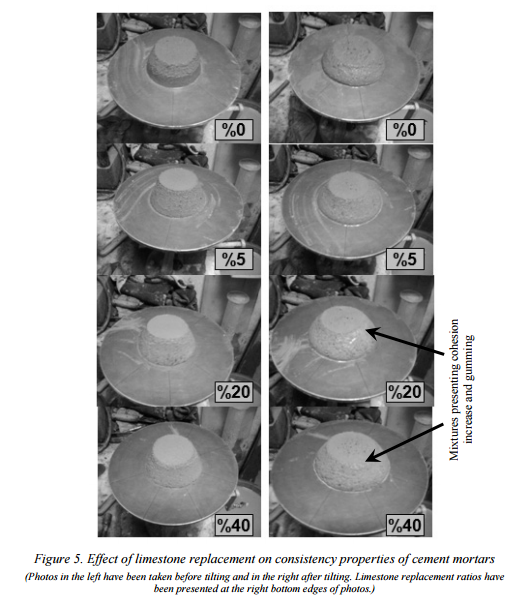
Pozzolan
Pozzolans strengthen and seal concrete mixtures, and are efficient in reducing the cement content. A pozzolan is defined as "a siliceous or siliceous and aluminous material, which in itself possesses little or no cementing property, but will in a finely divided form--and in the presence of moisture-- chemically react with calcium hydroxide at ordinary temperatures to form compounds possessing cementitious properties." [6] Types of Pozzolan's available:
- Rice Hull Ash
- Fly Ash (from coal)
Gypsum
Gypsum; “is a soft grey mineral consisting of hydrated calcium sulphate, occurring chiefly in sedimentary deposits. It can be used to make plaster and fertilizers, and is used vastly in the construction industry for its strength, malleability and accessibility as a common mineral [7]”. Gypsum can sometimes be found at a low cost because it is a byproduct of flue gas desulfurization (FGD), a process used by coal-fired electrical power plants to limit emissions of sulfur dioxide [7]. "This artisan method of manufacturing results in a finished product with exceptional binding capacity, making it suitable for use in outdoor environments [8]". As a soft material, Gypsum should be mixed in order to have cement properties. The ratio of water to gypsum in flooring is 0.8:1 in order to achieve a compressive strength of 6 MPa [9]. This ratio is not valuable in flooring until it is strengthened with a fiber.
Fiber
Potential
- Natural cork from cork Oak--lightens mixture [9].
- Wool--provides considerable improvement to compression layers in terms of mechanical behaviour. "Wool provides significant improvement, particularly in terms of compression and elasticity. Furthermore, this material is 100% ecological and the cost is significantly lower than that of many artificial fibers [9]".
| Flooring Recipe | |||||
|---|---|---|---|---|---|
| Ingredient | Amount | Description | |||
| Concrete | Six Bags of Concrete. | ||||
| Sand | Aggregate in mixture. | ||||
| Pozzolan | Ash | ||||
| AS 600 | Quick Dry | ||||
Floor Staining
Stains for concrete come in two general categories: acid-based chemical stains and water-based acrylics. Most acid stains are a mixture of water, hydrochloric acid and acid-soluble metallic salts. They work by penetrating the surface and reacting chemically with the hydrated lime (calcium hydroxide) in the concrete. The acid in the stain lightly etches the surface, allowing the metallic salts to penetrate more easily. Once the stain reacts, it becomes a permanent part of the concrete and won't fade, chip off or peel away. The palette for acid-etch staining is generally limited to earthy tones, such as tans, browns, terra cottas and soft blue-greens.
Both types of stain can be applied to new or old concrete, both plain or integrally colored. They are especially effective for revitalizing dull, lackluster surfaces. Because stains must be able to soak into the concrete to achieve full color saturation, they shouldn't be applied to surfaces covered by anything that can inhibit stain penetration, such as dirt, grease, glues, coatings, curing membranes and sealers. [10]
Iron Sulfate
Iron sulfate, also known as ferrous sulfate, is a chemical compound the can be found in different plant fertilizers. It is most commonly used for “greening plants, specifically azaleas and citrus plants.”[11] Ferrous sulfate can also be used to stain concrete and plaster an amber color. The resulting color depends on the amount of layers applied; it begins as an orange color and darkens with the application of more layers. It is a natural stain and creates no waste. Ferrous sulfate can be reapplied after years of wear and tear. One must make sure not to apply too many coats because the concrete or plaster will no longer have room to absorb the chemical. One must also wear gloves as the chemical has been known to burn hands. Ventilation is also important as it will need help drying. Before being stained, the concrete must be properly cleaned and cleared of dust and other unwanted sediments. Once clean, the stainer can be applied using a clean mop or a paint roller.[12] A Humboldt state student used the following ratios to stain concrete floors at their school's appropriate technology center. The step-by-step description of their process can be found here
- 1 lb (16 oz) iron sulfate to 1 gallon (4 quarts) water ratio gives an orange stain.
- 2 lb iron sulfate to 1 gallon water + 1~2 cups coffee grounds gives a more saturated, darker look.
Plaster
About
Before delving into the specifics of plaster, it is beneficial to first know what plaster actually is. Plaster is “a material used to cover walls-- often both interior and exterior. It provides protection as well as texture and color”. There are many types of plasters, which will function better with different building materials, and some kinds of plasters are more environmentally sound and beneficial than others. For instance, earthen plasters- which include lime, gypsum, and clay are said to be "water resistant". [13]Below, different types of plaster will be presented and discussed.
Types
Lime and clay plaster types were mainly researched below as viable options; however, gypsum and cement mixtures were added to provide information about alternative plaster types that could be an option in building projects in general.
Clay
There are a variety of different clay-based plasters. Generally, they share similar components: about 20% clay, combined with sand, fiber, and any additional/optional ingredients. The clay is sticky- one of its sole purposes is to act as the binding agent which holds all of the ingredients together in a mixture. The sand not only provides strength, but it also prevents the plaster from cracking. The fiber ingredient, which could be "hair, straw, hemp, cattail fluff, [or] manure, adds reinforcement and strength to the structure as well. Additional ingredients could include flour paste (flour and water), prickly pear juice, lime, mica, or fine fiber." [14]
As mentioned previously, earthen plasters like clay are considered water resistant. The specific reason behind why clay plaster contains this property is because of its molecular make up. "According to soil scientists, clay consists of tiny flat plates. When moisture comes into contact with an earthen plaster, it binds to clay molecules and forms a bridge between them, causing the clay to expand. The binding of water molecules to clay also prevents water from migrating into the deeper layers: the plaster self seals."[13]
Although erosion may occur on the surface layers of an earthen plaster due to rain and change of temperature/weather, the deeper layers will still protect the wall through it all. [13]
Lime
Lime plaster is typically composed of lime and sand, and can be utilized for exterior or interior walls. Oftentimes, however, lime plaster is "usually applied on exterior walls where it provides excellent protection against the elements" [13]. Lime differs from other earthen plasters in the fact that it takes a somewhat energy-intensive process to get the lime from its naturally occurring source, such as limestone. To create lime, a type of powder called quicklime (heated and crushed limestone) must be hydrated in a process called 'slaking'. This is basically the calcium oxide and magnesium oxide reacting with water to create the lime paste that is used in lime-based plasters. This process works best over a large time frame. If lime plaster dries too quickly, it can destroy it completely as an efficient plaster. While lime is caustic and can cause extreme damage upon contact with skin or inhalation, there are many advantages to using lime. Lime plasters are not only aesthetically pleasing, but they are also "vapor permeable." [13] This allows for the movement of water molecules through the material, protecting against moisture-related issues such as rot and mold.
It is also important to note that lime plaster requires a lime wash every 4-5 years. [15] The wash is needed to allow the building to breath. Though it is expensive, it improves the condition of the underlying plaster. Lime plaster is best composed of high calcium and low amounts of magnesium. When stored, it is vital to have one or two inches of water on top to prevent carbonation from exposure to the air - just like in the process of making the plaster - and must be fully slaked before the application may begin. A desirable technique is to apply lime plaster in one to three coats of varying composition, and using a mortar mixer rather than a cement mixer, to avoid the material sticking to the walls of the drum. The first two coats use one part lime putty and two to three parts sand, while the last coat has a higher ratio of one and a half to three parts sand. Sand within the plaster adds tensile strength, but it is important to be aware of the type of sand being used. Small grains can cause the plaster to crack or rub off because of the lack of strength. Additionally, uniformly sized particles cause cracking due to the ability of the material to shear along many edges. The best sand to use is one that has non-uniformly sized particles, as well as particles without smooth edges that may shear easily. It is important to note that beach sand must be cleaned prior to use because of the salt content. Salt has a tendency to move out from the plaster, which creates white patches on the surface. [13]
Gypsum
In addition to requiring heat to create the Gypsum plaster it is also not suitable for outdoors in humid environments. [15] Gypsum plaster is "a more delicate wall plaster. It is rather soft and water soluble, and is therefore typically reserved for interior work" [13].
Cement Stucco
In cement stucco, which is actually different from plaster, cement is the binding agent. This type of mixture is generally containing "cement, sand, and (frequently) lime". Cement stucco, also known as "portland cement", "wicks moisture into the walls and it tends to crack", which can ultimately allow moisture into the building [13]. Concrete made of portland cement is usually composed of 15-20% portland cement- and for each pound of cement produced, one pound of carbon dioxide is released into the atmosphere originating from the machines needed to produce it as well as the chemical reaction.[16]
Past Projects
Las Malvinas Schoolroom
With a coffin manufacturer in the area, obtaining sawdust is easy and should be considered as a viable option to make plaster. In 2012 the Ecoladrillo school room was constructed using “3 layers of sawdust plaster” where the layers are composed of different ratios of cement and sawdust as previously discussed. The final layer does not contain sawdust for possible aesthetic reasons, but a tint was added to eliminate a need to paint [17]. To make the plaster 16 parts water with 1 part lime were added to a container to dissolve the lime, then 16 parts sawdust are added and let to soak for one hour. According to the past project reviews, this mixture should be added to 12 parts sifted sand to be mixed on a tarp on the ground. Then, add 8 parts cement and water as needed for the desired consistency [17]. For the final layer of plaster wait for the second layer to be mostly dry then apply a “long thin piece of wood to plane the wall, scraping off bulges and filling in holes with more plaster.” Apply the final layer and water as needed to create a smooth surface [17].
2013 Las Malvinas Botica Popular
To test the initial plasters it was decided to add a layer of paper outside of the chicken wire to allow the plaster to adhere to something other than the chicken wire and water bottles. The first layer of plaster was composed of “18 shovels-full of sand and 1/3 of a bag of cement.” The second layer was made to be thinner and again, less sand with the last layer. [18].
Construction
Very complete description of how final project is made. This large section should have lots of pictures. Please consider making a timeline in addition or instead. Use the Help:Images#Galleries and probably Template:How_to (e.g. Barrel O' Fun Worm Bin Instructions).
How To
Below, is a table describing a common method of plastering a wall. This table is built on the assumption that one has already gathered materials/supplies and have already made the plaster being used. Also note that there are many different methods of applying plaster to a wall; however, the following table describes one of these ways.
The following table describes the two main tests performed on a dry, plastered wall. These tests will determine whether the plaster will be sufficient in providing enough strength and resilience to use on the wall.
Tips & Tricks
Plaster
- Use the trowel to mix the water in with the plaster to ensure the correct consistency
- Use the trowel to lift some of the plaster and drop it. Do this three times until you have a smooth consistency, now the plaster should be put on the flat rectangle finishing trowel.
- When smoothing, the wall must be wet to use the wood float, but it's much easier to use a sponge to both wet, and smooth the wall.
Yeso
- Usa la plana para mezclar el agua con el yeso para asegurar la consistencia correcta.
- Próximo, usa la plana para levantar alguno del yeso y después, bajalo. Hace este tres veces hasta tiene una consistencia suave, ahora el yeso debe poner en la llana.
- Para ponerlo liso la pared necesita a estar mojada para usar la flota, pero es muy más fácil para usar la esponja para mojar y poner liso en la pared.
Timeline
The following is a timeline composed of the tasks assigned and achieved as well as the dates.
28 May 2015
Literature review
- Finished 01 June 2015
28 May 2015
Community meeting at Las Malvinas II
29 May 2015
Meeting with Eddie at Las Malvinas II
- Took notes on current state of Destacamento: how many blocks, current square footage
- Took notes on current state of Botica Popular: which walls need plaster, what square footage needs plaster, of what composition are the current blocks and plaster
03 June 2015
Meeting with Gregorio and Enrique
- Made list of materials needed to both purchase and obtain from the community
- Made tentative schedule for following two weeks
05 June 2015
Made first iteration of caliche plaster recipe and applied to an inner wall of the Botica
06 June 2015
UNIBE Architecture camping day
07 June 2015
Research on plaster to decide on materials needed to purchase
08 June 2015
Tested dried plaster on inner wall of Botica and gathered supplies
09 June 2015
Made 6 different plasters to test that all include different materials such as two types of sand, flour, human hair collected from a local barber
- Flour was made correctly this time by first dissolving the flour in cool water before adding it to the boiling water
10 June 2015
Researched on flooring to decide on materials needed to purchase
11 June 2015
Tested 6 plaster tests, gathered supplies for floors and plaster
- Plaster without hair preformed better in the scratch test
- Darker sand preformed better on water test, lighter sand preformed better in scratch test
12 June 2015
- Removed some of the previous plaster as well as some of the filling and bottles - prepping wall to be plastered, attempting to even out
- Placed some of the wood framing on the walls
13 June 2015
- Bought supplies to get ready for plastering
- Double-sifted caliche and sand
- Placed wood framing on walls that needed it
14 June 2015
- Plastered three interior walls, window frame, one outside wall and began plastering on two other outside walls
16 June 2015
- Plastered over walls whose plaster did not pass our brush and/or water test
- Smoothed many of the walls plastered
- Plaster needed for one entire wall and a small amount to the outer wall then smoothing for both
- Shoveled much of the large waste plaster and dirt out of the building to prep for the flooring
18 June 2015
- Continued plastering and smoothing in the botica
19 June 2015
- Ordered materials to use for the floor in the Botica since the previously purchased cement was used in plastering
20 June 2015
Beach day, required relaxation
21 June 2015
- Continued plastering the botica, finished the second room's horizontal beam, and began plastering the first room's horizontal beam
- Plastered the doorway
23 June 2015
- Split up into groups: one group for plastering the botica and cleaning the floors, and the second group for more block making.
- Horizontal beam and in front room and doorway of entryway worked on, only missing one side of the horizontal beam and whatever tiny fill-ins are left
Costs
The following table includes all purchases made to contribute to the Botica Popular. Items are listed multiple times according to how many times they were purchased. Some items were purchased at the same location and some were not.
| Cost of materials | |||||
|---|---|---|---|---|---|
| Material | Source | Quantity | Costo (RD$) | Cost ($) | |
| 25 lb Harina | Colmado Genesis | 1 | 500 | 11.14 | |
| Caja Plastica 2" | Ferreteria Cuesta | 4 | 60 | 1.34 | |
| Pala Cuadrada | Ferreteria Cuesta | 2 | 760 | 16.93 | |
| Nicholson Hoja Segueta | Ferreteria Cuesta | 2 | 74 | 1.65 | |
| Bellota Llana P/AL | Ferreteria Cuesta | 2 | 440 | 9.80 | |
| Flota de Madera | Ferreteria Cuesta | 4 | 164 | 3.65 | |
| Flota de Goma | Ferreteria Cuesta | 4 | 140 | 3.12 | |
| 1/2 lb Clavos Acero | Ferreteria Cuesta | 1 | 28 | 0.62 | |
| Martillo | Ferreteria Cuesta | 1 | 235 | 5.24 | |
| Plywood 1/2" (4'x8') Okume o Brazil | Ferremix | 1 | 980 | 21.83 | |
| Madera 1"x4" de 14' Bruta PinoAmer | Ferremix | 7 | 1505 | 33.53 | |
| Cepillo de Acerco | Farmacia Carnina | 1 | 35 | 0.78 | |
| Plana Albañil | Farmacia Carnina | 2 | 100 | 2.23 | |
| Cubeta Plastica 4x5 | Farmacia Carnina | 2 | 300 | 6.68 | |
| Cal de 10lb | Ferreteria Suazo | 1 | 60 | 1.34 | |
| Cedazo para Albail de Madera | Ferreteria Suazo | 1 | 225 | 5.01 | |
| Guantes Damas | Ferreteria Suazo | 3 | 135 | 3.01 | |
| Plana China #7 | Ferreteria Suazo | 2 | 120 | 2.67 | |
| Mascarilla Especial | Ferreteria Suazo | 7 | 420 | 9.36 | |
| Cal Hidratada | Innova Centro | 2 | 576 | 12.83 | |
| Funda de Cemento | Ferreteria Vasquez Martes | 6 | 1380 | 30.74 | |
| Metero Cúbico de Arena | Ferreteria Vasquez Martes | 1 | 800 | 17.82 | |
| 1 Libra de Harina | Ferreteria Vasquez Martes | 4 | 80 | 1.78 | |
| Guantes Industrial de Latex | Super Potente el Defensor del Bolsillo | 2 | 132 | 2.94 | |
| Pítcher Plastico | Super Potente el Defensor del Bolsillo | 1 | 145 | 3.23 | |
| Martillo | Ferremix | 1 | 315 | 7.02 | |
| Martillo | Ferremix | 1 | 187 | 4.16 | |
| Guantes | Ferremix | 2 | 290 | 6.46 | |
| Lona de 3x4 | Ferremix | 1 | 490 | 10.91 | |
| Cinta Metrica 8mts. | Ferremix | 2 | 400 | 8.91 | |
| Mini-Pala P/Jardin | Ferremix | 3 | 240 | 5.35 | |
| Galon de Gasolina (cocina la harina) | Propa Gas | 12.2 | 1000 | 22.27 | |
| Scoba | Tienda Local | 1 | 125 | 2.78 | |
| Guantes Damas | Ferreteria La Formula | 2 | 100 | 2.23 | |
| Llana | Ferreteria La Formula | 1 | 225 | 5.01 | |
| Libra Empañete | Ferreteria Local | 1/4 | 225 | 5.01 | |
| Libra de Harina | Colmado Genesis | 4 | 80 | 1.78 | |
| Libra de Harina | Colmado Genesis | 3.5 | 60 | 1.34 | |
| Fundas de Cemento | Ferreteria Vasquez Martes | 7 | 1610 | 35.87 | |
| Fundas de Cemento | Ferreteria Vasquez Martes | 7 | 1610 | 35.87 | |
| Metero Cúbico de Arena | Ferreteria Vasquez Martes | 1 | 800 | 17.82 | |
| Fundas de Cemento | Ferreteria Vasquez Martes | 9 | 1980 | 44.09 | |
| Metero Cúbico de Arena | Ferreteria Vasquez Martes | 1 | 800 | 17.82 | |
| Mascarilla Desechable | Ferrecentro Peque | 70 | 70 | 1.56 | |
| Guante Motorista Trupper | Ferreteria Suazo | 2 | 120 | 2.67 | |
| Alambre Picodo | Ferreteria Vasquez Martes | 2 | 80 | 1.78 | |
| Disco Corte | Ferreteria "Santa Ana" | 3 | 615 | 13.70 | |
| Barra Cuadrada 1/2x20 | Forjados del Caribe | 8 | 2407 | 53.60 | |
| Perfil Negro 1x1 | Forjados del Caribe | 8 | 742 | 53.60 | |
| Tola Negra Lisa 1/20 4x8 57lb | Forjados del Caribe | 1 | 1132 | 25.21 | |
| Tola Negra Lisa 1/20x48x48 (Mitad) | Forjados del Caribe | 1 | 597 | 1329 | |
| Cerr. Yale Italy 610-40 | Forjados del Caribe | 1 | 1097 | 24.43 | |
| Pestillo -PL-5/8 M/Largo | Forjados del Caribe | 1 | 110 | 2.45 | |
| Domastur, Mant. Gris Claro | Forjados del Caribe | 2 | 494 | 11.00 | |
| Thinner 1/2 Boltella | Forjados del Caribe | 2 | 102 | 2.27 | |
| Brocha Zeus 2" | Forjados del Caribe | 2 | 68 | 1.51 | |
| Total | 28781 | 640.93 | |||
| Cost of materials (Electric Supplies for Solar Team) | |||||
|---|---|---|---|---|---|
| Material | Source | Quantity | Costo (RD$) | Cost ($) | |
| Tomacoriente Blanco | Ferreteria Cuesta | 8 | 544 | 12.12 | |
| Alambre Electrica (200 pies) | Ferreteria Cuesta | 2 | 2080 | 46.34 | |
| Bticino Caja Plastica | Ferreteria Cuesta | 5 | 135 | 3.01 | |
| Caja T/GE Breaker | Ferreteria Cuesta | 1 | 420 | 9.36 | |
| Tijera Forjada Corte | Ferremix | 1 | 210 | 4.68 | |
| Tape Electrico | Ferreteria Cuesta | 1 | 47 | 1.05 | |
| Caja Electrica 2x4 | Ferremix | 3 | 102 | 2.27 | |
| Tubos 1/2x19 | Ferremix | 5 | 294 | 6.55 | |
| Total | 3832 | 85.75 | |||
Tests
Plastering Day 1:Recipe
All measurements have been taken using a 5 gallon bucket with a 12 inch diameter. Some measurements are in inches some in centimeters for greatest degree of accuracy.
Todas las medidads estan echas usando un cubete de 5 galones con un diámetro de 12 pulgadas. Unas de las medidas estan en centímetros mientras otras estan en pulgadas para mayor grado de precisión.
| Plastering Day 1 Recipe | |||||
|---|---|---|---|---|---|
| Componente | Amount | Español | Source = Fuente | ||
| Flour = Harina de Trigo | 6 lb 4 oz | 6 lb 4 oz | Colmado en Las Mavinas | ||
| Water = Agua | 3 gallons | 3 galones | Enrique y Marta | ||
| Lime = Cal | 1/4 bucket = 2.75 inches from bottom | 1/4 de un cubete = 2.75 pulgadas del base | Ferreteria | ||
| Caliche | 9.25 cm from the bottom | 9.25 cm del base | Donated by Vasquez | ||
| Sand = Arena | Donated by Vasquez | ||||
Plastering Day 1
Steps
See Botica Plastering Day down page for more accurate wheat paste plaster instructions
Plastering Day 2: Instructions
| Caliche Plaster One | |||||
|---|---|---|---|---|---|
| Steps | Instructions | ||||
| Step 1 | Boil water and mix in flour | ||||
Operation
This is how to operate. It should have a brief introduction and very useful images with labels. Also it may work best for your project to use the step by step how to template {{How to}}. See #Troubleshooting for an example.
Maintenance
Introduce this maintenance section.
Schedule
This is when to maintain what.
- Daily
- A daily task
- A daily task
- Weekly
- a weekly task
- a weekly task
- Monthly
- a monthly task
- a monthly task
- Yearly
- a yearly task
- a yearly task
- Every __ years
- task
- task
Instructions
This is how to use and maintain it. The step by step how to template {{How to}} is most likely best for this part.
| How To | |||||
|---|---|---|---|---|---|
| Image | Steps for completion | ||||
| Backpack frame bike trailer |1 |Do something. | Aleiha's parabolic solar cooker |2 |Do something really complicated but made simple, etc. | ||||
Conclusion
Testing results
Below, are the recipes used and results gathered from the different wall plasters applied and tested.
| Ingredient | Type of measurement | Plaster 1 Qty | Plaster 2 Qty | Plaster 3 Qty | Plaster 4 Qty |
|---|---|---|---|---|---|
| Yellow Sand | qty | qty | qty | qty | qty |
| Black Sand | qty | qty | qty | qty | qty |
| Human Hair | qty | qty | qty | qty | qty |
| Secante (AS 600 Dryant) | qty | qty | qty | qty | qty |
| Flour Paste | qty | qty | qty | qty | qty |
| Cement | Bag (90 lbs) | qty | qty | qty | qty |
| Lime | Bag (approx. 1 5-gallon bucket) | qty | qty | qty | qty |
| Scratch Test | Passed? | Passed? | Passed? | Passed? | |
| Water Test | Passed? | Passed? | Passed? | Passed? | |
Discussion
Discuss the testing results.
Lessons learned
Discuss lessons were learned during this project and what you would do different next time.
Next steps
Discuss any next steps for the project as it goes on into the future.
Troubleshooting
This is only how to troubleshoot basic operation. For complex issues, the solution might just say contact ________. It should be a table in this format:
| Troubleshooting | |||||
|---|---|---|---|---|---|
| Problem | Suggestion | ||||
| Example issue | Example solution or suggestion | ||||
| Does not turn on | Make sure it is plugged in | ||||
| Another issue | Et cetera | ||||
Team
Introduce team and semester in the following format:
- Lonny Grafman
- for each team member.
Grading criteria for the remaining sections:
- Grammar and spelling +1
- Formatting +1
- Depth, breadth and accuracy of content +7
- Project documentation's potential for impact (e.g. reproduction) +1
References
Make sure to include other relevant categories at the bottom, e.g. [[Category:Rainater]], [[Category:Upcycling]], etc.
- ↑ http://www.weather-and-climate.com/average-monthly-Rainfall-Temperature-Sunshine,Santo-Domingo,Dominican-Republic
- ↑ 2.0 2.1 http://geography.about.com/library/cia/blcdominican.htm
- ↑ http://www.doityourself.com/stry/how-to-lay-a-concrete-basement-floor-part-2
- ↑ https://www.google.com/url?sa=t&rct=j&q=&esrc=s&source=web&cd=1&ved=0CB0QFjAA&url=https%3A%2F%2Fsites.udel.edu%2Fdct%2Ffiles%2F2014%2F06%2FPortland-Limestone-PCA-Show-2014-2-1e9k2wx.pptx&ei=FW9sVaGFKJf_yQTcjoOIDg&usg=AFQjCNFLP3jtu9a4pi9A65eswkc1wOFR6w&sig2=WzkPZg91z7h3QhnLgOft2w&bvm=bv.94455598,d.aWw&cad=rja
- ↑ http://www.imo.org.tr/resimler/dosya_ekler/db64e9634c94de4_ek.pdf?dergi=474
- ↑ http://ferrocement.net/ferro/files/pozzolans-uwe.html
- ↑ 7.0 7.1 http://minerals.usgs.gov/minerals/pubs/country/1994/9510094.pdf
- ↑ http://valentinacristini.blogs.upv.es/files/2014/02/10.11648.j.am_.20130204.11.pdf
- ↑ 9.0 9.1 9.2 http://valentinacristini.blogs.upv.es/files/2014/02/10.11648.j.am_.20130204.11.pdf
- ↑ http://www.concretenetwork.com/stained-concrete/
- ↑ http://www.appropedia.org/CCAT_natural_concrete_stain
- ↑ http://www.solarhaven.org/FerrousSulfateStaining.htm
- ↑ 13.0 13.1 13.2 13.3 13.4 13.5 13.6 13.7 Guelberth, Cedar, Chiras, Dan (2002). The Natural Plaster Book: Earth, Lime, and Gypsum Plasters for Natural Homes. New Society Publishers.
- ↑ Earthen Plaster. [Online] Available http://sustainablenations.org/Resources/NATURALPLASTERS.pdf
- ↑ 15.0 15.1 One Community [Online] Available http://www.onecommunityglobal.org/plaster/#types
- ↑ Gadja, John W., VanGeem, Martha G.(2001). A comparison of Six Environmental Impacts of Portland Cement Concrete and Asphalt Cement Concrete Pavements. Portland Cement Association.
- ↑ 17.0 17.1 17.2 Appropedia: Las Malvinas ecoladrillo schoolroom. (2013) [Online] Available http://www.appropedia.org/Las_Malvinas_ecoladrillo_schoolroom_2012/Literature_Review , June 24, 2013
- ↑ Appropedia: Las Malvinas botica popular ecoladrillo. (2013) [Online] Available http://www.appropedia.org/Las_Malvinas_botica_popular_ecoladrillo_2013#Plaster, August 28, 2013
